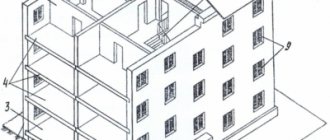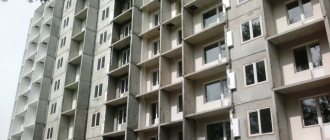Commercial real estate can be divided into several groups operational intentions. It is worth noting that this type of real estate is not suitable for housing in almost all cases, but it also has small exceptions to this rule when it comes to a group of apartments. Further in this article we will talk about groups of real estate commercial objects, their direct purpose for making a profit and their classifications.
World and Russian practice: what systems are used?
In international practice, several classifications of office real estate are used , but the system developed by BOMA (Building Owners and Managers Accociation) is considered the most used. Business centers are classified according to categories “A”, “B” and “C”.
Office premises of class “A” are the most prestigious and of high quality; the characteristics of class “C”, in turn, are far from modern requirements. Classifying an office into one class or another is to a certain extent subjective and is made taking into account compliance with certain characteristics:
- Location.
- Building type.
- The novelty of the building.
- Building maintenance systems, security system.
- Solutions in the planning, decoration and construction of the building.
- Engineering systems, air conditioning and ventilation systems.
- Telecommunication systems.
- Parking.
- The building is equipped with elevators.
- Infrastructure.
In Russia, a unified classification of office premises has not yet been approved. There are many variations of systems used on the market, but they are all based on similar principles.
The most famous classifications are:
- Classification of the chief analyst of the Russian Guild of Realtors G.M. Stubble.
- Classifications of the Moscow Research Forum, developed in 2003 and updated in 2006 and 2013.
- Classification of the St. Petersburg Research Forum 2008
Many appraisal companies use a system similar to ABC . In Russian realities, some companies add a special category “D”, which is due to the fact that many buildings date back to the Soviet era, have not been reconstructed and do not even meet the requirements of category “C”.
In accordance with the tightening requirements at the Moscow Research Forum in 2006, the 2003 classification was changed. The new structure divides modern office buildings into three types: “A”, “B+” and “B-”. Buildings that do not meet the specified criteria are classified as classes “C” and below. In 2013, an important innovation was the “Certification” item, that is, the compliance of office centers with international energy efficiency standards: LEED and BREEAM.
The second classification system involves dividing class “A” into additional categories: “A1”, “A2”, “A3” and is more detailed. The companies Noble Gibbons and Colliers International use it in their practice. The division into subclasses “A+”, “A” and “A-” is similar.
Types of design
There are three main types of office design:
- Architectural.
- Technological.
- Engineering.
We offer a general overview of each of these types of work.
Architectural
It consists of creating and visualizing an image of a future office building. This is necessary for the formation of a general concept, selection of building and finishing materials, furniture, and facade finishing. As a rule, if an office is designed for the activities of one company, its corporate values are expressed in the architecture. At the same time, office premises must remain convenient, comfortable, ergonomic and safe, which is necessary to achieve maximum productivity during work.
Technological
Technological design consists of developing an office space that corresponds to the specifics of the enterprise’s activities and also has all the necessary functional premises and rooms. Accordingly, one of the most important tasks at this stage is to work out the optimal layout. It can be developed individually, or partially copied from standard template solutions that work well in practice.
Engineering
No modern office is possible without well-thought-out and efficiently operating engineering and communication networks. This includes electrification, lighting of premises in accordance with current standards, plumbing, sewerage, heating, ventilation and air conditioning. A very important component of any modern office are telecommunications and low-current networks, which are needed both for internal efficient activities and communication with the outside world.
Class "A"
Business premises, which are the optimal solution for office premises, are located in new complexes with competent planning, a high level of construction and finishing, automated life support systems, equipped with security, communications and communication systems. Such offices are mainly built in the city center or in prestigious areas with a large number of transport links.
The tenants of premises in high-class business centers are large companies and branches of foreign companies that fully meet all the criteria of a modern building, which include:
- Availability of a central building management system.
- Availability of a modern fire safety system.
- The ceiling height is at least 2.7 m.
- High-quality finishing materials for common areas and facades.
- The waiting time for elevators is no more than 30 seconds.
- The depth of the floor from the window to the “core” does not exceed 10 m.
- Availability of an effectively organized reception area, conference rooms, spacious food and recreation areas.
- Designer renovation.
- Multi-level ground or underground parking with an entrance to the business center.
For class “A”, division into subclasses is practiced: “A1”, “A2”, “A3”, which have no fundamental differences among themselves and are used to define the building in more detail.
Subclass "A1"
This subclass is characterized by:
- The building is less than 3 years old.
- The ability to completely customize the indoor microclimate to suit individual needs.
- Rational and ergonomic layout that promotes effective interaction.
- Availability of a restaurant and cafeteria.
- Bright windows, at least 80% of which face the street.
- Duplicated basic life support systems.
- Location in the central part of the city, convenient access to the building.
"A2"
It has less stringent requirements for the location of the building, and can also be a completely reconstructed building of relatively recent construction. The characteristics are close to class “A1”, but allow minor deviations in minor parameters.
"A3"
Can be assigned to a completely reconstructed building 20-30 years old. Relatively inefficient layouts and inferior central air conditioning systems are acceptable.
There may be some deterioration in relation to the “A2” subclass, for example, the location of the office center is not in the central, but in a more remote but prestigious area.
Commercial real estate: classification
Along with the increase in rental rates, the requirements for real estate are also increasing . But, unfortunately, often in many regions, when asked what criteria you use to distinguish between business centers or warehouses, two categories are distinguished: cheap and expensive, center or periphery. But is this right?
Just a year ago, Russian real estate experts hoped and believed that the domestic market would take another step towards civilized business by adopting a unified classification system for retail premises and a similar system for warehouse premises. More than one real estate agency and more than one consulting company have made their own, to one degree or another successful, attempts to streamline the situation in the retail real estate market, but they have not come to an agreement.
And at the end of 2006, at the Moscow Research Forum, four consulting companies adopted a new classification of office buildings in Moscow, which imposes more stringent requirements on business centers.
However, the new standards for office buildings are mainly suitable for Moscow and the regions cannot take advantage of these developments. Some parameters are tied specifically to the Moscow scale.
But regions also need an objective assessment of existing and under construction buildings. Experts believe that the lack of a unified approach to determining the type of commercial real estate is hindering the development of a healthy market in our city.
In Western practice, commercial real estate is divided into four main classes A, B, C and D. However, for Russian conditions, such a classification of real estate is too general, and at the same time contains many halftones, and a significant part of buildings cannot be classified even to class D.
Next, we bring to your attention a classification of real estate objects, which is convenient to use in our activities.
| Name | Description | |
| Characteristic | Meaning | |
| Class A | Purpose | Business centers |
| Age of the building | New construction | |
| Location | First class. Location on the main transport arteries and squares, with convenient access | |
| Constructive decisions | Monolithic frame, metal frame building. Possibility of installing false floors and suspended ceilings; the height from the floor to the floor of the next floor is at least 3.6 m (at least 2.7 m from the raised floor to the suspended ceiling when finished) | |
| Planning solutions | Optimal. Rational effective grid of columns (distance between columns is at least 6 m), rational relationship between columns and windows | |
| Architecture and decoration | Individual (author's) project. Exterior finishing with high quality materials. Interior decoration according to individual order of the tenant. Panoramic glazing | |
| Engineering | High quality from foreign manufacturers. Automated life support systems. Fully controlled indoor microclimate, maintaining constant temperature and humidity using a single combined ventilation, heating and air conditioning system (usually carried out using four-pipe fan coils). Modern building security systems;UPS (uninterruptible power supply) | |
| Infrastructure and service | Deployed infrastructure for centralized provision of tenants with office equipment, communications and telecommunications equipment, conference rooms, consumer services and recreational facilities | |
| Parking | Sufficient number of parking spaces in the underground parking lot. Guarded parking lots with at least one space per 60 sq. m of office space. | |
| Building management | Professional management that meets international standards. Professional experienced landlord. The building is kept in impeccable condition and has its own security, management and maintenance services. Availability of correctly completed legal documentation for ownership and operation rights | |
| Class B | Purpose | Business centers, office buildings |
| Age of the building | Business centers after 5-7 years of operation, or special new office buildings, or reconstructed mansions | |
| Location | Non-compliance with some requirements for class A (distance from transport arteries, inconvenient access) | |
| Constructive decisions | Monolithic frame, metal frame, brick buildings. Possibility of installing false floors and suspended ceilings | |
| Planning solutions | Non-compliance with some requirements for class A (due to obsolescence of the object) | |
| Architecture and decoration | ||
| Engineering | Fully controlled indoor microclimate, maintaining a constant temperature using a single combined ventilation, heating and air conditioning system; modern building security systems; sufficient engineering support; UPS (Uninterruptible Power Supply) | |
| Infrastructure and service | Less wide range of services | |
| Parking | Parking with sufficient parking spaces | |
| Building management | Building management that meets international standards; professional experienced landlord; availability of correctly completed legal documentation for the right of ownership and operation of the building | |
| Class C | Purpose | Office buildings |
| Age of the building | Obsolete office buildings, reconstructed buildings for other purposes | |
| Location | With disadvantages in location (distance from transport arteries, inconvenient access) | |
| Constructive decisions | Possibility of installing suspended ceilings | |
| Planning solutions | Fairly efficient floor plans | |
| Architecture and decoration | There are no architectural requirements. Repairs that meet Western standards | |
| Engineering | Supply air pre-cooling system (comfort cooling) or split air conditioning system | |
| Infrastructure and service | Insufficient infrastructure for business and leisure services | |
| Parking | Insufficient number of parking spaces | |
| Building management | 24-hour security; good maintenance service; experienced landlord | |
| Class D | Purpose | Non-residential premises in administrative and office buildings, research institutes, adapted for offices |
| Age of the building | More than 10 years | |
| Location | There are no requirements | |
| Constructive decisions | ||
| Planning solutions | ||
| Architecture and decoration | More or less quality repairs | |
| Engineering | Outdated engineering communications | |
| Infrastructure and service | There are no requirements | |
| Parking | ||
| Building management | Lack of specialized operation and life support services | |
| Class E | Purpose | Non-residential premises in residential and non-residential buildings, adapted for offices (first floors and basements of residential buildings, former kindergartens, etc.) |
| Age of the building | There are no requirements | |
| Location | ||
| Constructive decisions | ||
| Planning solutions | ||
| Architecture and decoration | More or less quality repairs | |
| Engineering | Outdated engineering communications | |
| Infrastructure and service | There are no requirements | |
| Parking | ||
| Building management | ||
| Class F | Purpose | Same as class E, but not suitable for offices and not renovated (unfinished) |
| Age of the building | ||
| Location | ||
| Constructive decisions | ||
| Planning solutions | ||
| Architecture and decoration | Needs reconstruction and repair (finishing) | |
| Engineering | Same as class E | |
| Infrastructure and service | ||
| Parking | ||
| Building management |
To be continued... Elena Andreeva
Network of Real Estate Agencies "EXPERT"
"IN"
Economy class offices, as class B office space is often called , often have no fundamental differences from a class A office. Unlike class “A”, which refers to representative premises, commercial real estate of class “B” refers to work premises. Large companies locate personnel other than top management in such offices. Tenants are small organizations and companies.
Such premises are characterized by:
- The location is not in the central areas of the city.
- The service life of the building does not exceed 10 years.
- High-quality finishing, ceiling height of at least 3 m..
- Well-equipped recreational and common areas.
- Organized guarded parking.
- Developed building and business maintenance infrastructure.
Retail real estate
Retail facilities are commercial real estate that is prepared for organizing small wholesale and retail sales of goods and services. Commercial as well as entertainment establishments are at the intersection of the real estate market and other areas of business in combination with retail and entertainment businesses. A shopping and entertainment center or a trading house - these objects are known to everyone, but the correct organized system of a shopping and entertainment platform is undoubtedly a whole science.
"WITH"
Class “C” offices are predominantly located in Soviet-era buildings repurposed for office needs: research institutes, institutes, and plant managements.
A building of this type is often characterized by a complete lack of central air conditioning, unprofessional management, and lack of equipped parking.
The renovation was carried out using cheap materials, but there are problems with electrical voltage and infrastructure. Main characteristics of class “C” office premises:
- Location on the outskirts of the city, inconvenient access to the building.
- Service life exceeds 10 years.
- Standard renovation, corridor system.
- Outdated design, inefficient layout.
HIGH-QUALITY LIGHTING INCREASES PRODUCTIVITY
In enterprises and office premises, the level of light sufficiency plays an important role in employee fatigue and their readiness to work at computers for long periods of time.
- Lack of light leads, for example, to damage to vision.
- Weak light increases eye strain; workers interact less with the computer and make frequent mistakes.
- If the office is associated with IT solutions and developments, then this also has its own nuances. Too harsh light will not allow programmers to work at the computer for a long time. And too soft light will relax them and make them sleepy.
- Create different lighting atmospheres in your office. In the eating area the light will be softer. And in the working area there should be less light. Let there be soft daylight in the recreation areas.
Do not forget to check the illumination to the level of GOSTs, SNIPs, and legal requirements.
"D"
Properties classified as class “D” do not meet the requirements of a modern office property. Offices of this class are characterized by outdated engineering solutions, wooden floors, and lack of life support services. They are located outside the city, in converted warehouses and production facilities, and in residential buildings.
Class “D” is characterized by:
- The condition of the building requires major repairs.
- Corridor system, location in basements and semi-basements, lack of quality planning.
- The parking is spontaneous and unguarded.
- Lack of building maintenance and management infrastructure.
Industrial real estate
Industrial real estate and production facilities are a rather specific segment of the real estate market. For a long time, due to stagnation in Russian production, it remained incompletely studied, underestimated and unclaimed. However, manufacturing capacity has recently been regaining its importance. Technology parks are important in this segment, as is the problem of reconstructing industrial zones of large companies.
Commercial property includes industrial buildings (warehouses, buildings where capacity is managed) and even land plots that are used or planned to be used for industrial construction and the formation of warehouses.
From all of the above, we can conclude that any buildings, premises, sites and land plots not intended for residential premises can be used for commercial purposes.
By constantly analyzing the area of commercial real estate, it is possible to determine the needs of the market, which will increase its capitalization. Selecting high-yield commercial real estate is a very difficult task. Only a professional broker or consulting agent can successfully handle it. But it is worth considering that the price for their services is still very high.
Range of real estate prices for offices
Prices for office real estate depend on many factors , the main ones being distance from the center and compliance with a particular category. The average rental rate for a class A office in 2021 in Moscow is RUB 25,500. per sq.m. per year, a “B+” class office can be rented for an average of 16,000 rubles/sq.m. per year, and sq.m. in a class “B-” office it will cost 14,500 rubles. in year. Office rent in the lower category is, on average, 9,000 rubles/sq.m. in year.
If you are interested in learning about different office transactions, read about renting and buying and selling.
The need for a correct assessment determines the importance of using and constantly updating the most convenient and complete classification for all market participants. Clear criteria provide a clear picture of what the tenant is willing to pay money for, and what choices and options the landlord is willing to provide.
Office real estate
An office is commercial real estate, with the help of which it is possible to generate income in all directions. For example, produce a specific service or product that will be used in the future, allowing you to form the economy of a particular market segment.
Based on this definition, it can be understood that office real estate is still considered to be a popular type of commercial real estate in Moscow and other large cities of Russia. To develop a business, people constantly need to buy or rent offices, which means that the cost of office real estate will invariably increase, and more and more space will be allocated for its construction.
It is very difficult to give a clear definition of the concept of office real estate, because with this type of object one can mean almost any enterprise.
Class "B"
Class “B” premises are located one step lower in the hierarchy of office buildings than class “A” offices. They are also called budget offices or economy class offices. At the same time, their differences are not fundamental: these buildings do not pretend to be a business center, but almost completely meet the requirements of Western companies for ergonomics and engineering; Simply good materials are used in the decoration (without exclusivity); They are managed predominantly by Russian companies, which, with a slight stretch, can be called professional managers. For the most part, class “B” office buildings are class “A” offices after 5-7 years of operation, although there are also reconstructed buildings from a later period, mansions in the center of Moscow after complete refurbishment and renovation.
Recently, the following trend has been observed in the office real estate market: companies rent class “A” offices to accommodate top management and representative purposes, and cheaper class “B” and, in some cases, “C” offices are used to accommodate the bulk of the staff. "
In Moscow
Full awareness of the classification of office real estate today, even in Moscow, is not yet a key condition for doing business, since along with 1.5 million sq. m. m class "A" and more than 4.5 million sq. m. m of class “B” space is operated over 25 million sq. m. m of class “C” and “D” premises. A significant part of the objects is subject to redevelopment into class “B”, i.e., as before, a significant part of new high-quality offices are the reconstruction of old ones. Among the objects put into operation, class “B” predominates. Foreign companies prefer class A, while class B is traditionally more attractive for Russian companies.





